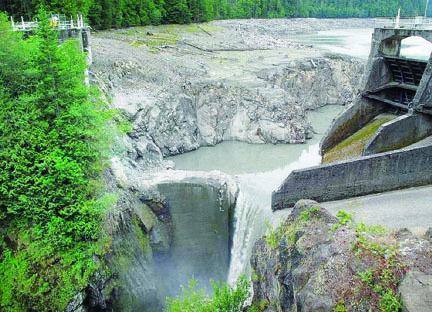PORT ANGELES — Explosives will tear off more of Glines Canyon Dam beginning Monday.
“We’re ready to go. The holes are drilled for the next blast,” said Brian Winter, Elwha River restoration manager.
Beginning Monday and continuing through July 31, the dam — once 210 feet high and now 110 feet high at its lowest point — will be lowered again by blowing open notches at the top of the dam.
The work is part of the $325 million Elwha River restoration project that began in September with the beginning of the demolition of Elwha Dam, built in 1913, and Glines Canyon Dam, built in 1923 — both of which were constructed without fish ladders.
Elwha Dam, 5 miles from the mouth of the river, was removed earlier this year, and Lake Aldwell behind it has drained.
Gone by next summer
Glines Canyon Dam, 8 miles upriver from the former Elwha Dam, is expected to be demolished by the summer of 2013.
Officials said blasting this week will release large amounts of water from Lake Mills, which formed behind the 89-year-old cement Glines Canyon Dam.
The increased flow in the Elwha River downstream from Glines Canyon is expected to be sudden in spurts but will not be a tsunami-like rush of water, Winter said.
During the blasting, Altair Campground, located just south of Glines Canyon, will be closed to visitors because of low-lying areas where waders or swimmers may be caught unaware by suddenly increased flows.
Sudden increases in flow
Visitors to the Elwha River should be aware of the possibility of sudden increases in river flow during the blasting, Winter said.
Olympic National Park also is asking that visitors to the empty lakebed that was once Lake Aldwell remain at least 20 feet from the eroding sediment cliffs.
“Riverbanks are actively eroding and may be unstable,” the park’s website states.
The area around Glines Canyon Dam is closed to the public, but a webcam set up by the U.S. Park Service to monitor the dam’s progress can be viewed via www.peninsuladailynews.com.
30-minute refresher
The webcam refreshes every 30 minutes during daylight hours and can be viewed as a time-lapse video.
Crews will be working as quickly as possible because there is only one month before the next fish window, periods of time when work that alters the river’s flow must stop while fish are migrating to and from the Elwha River.
A section of Glines Canyon Dam that towered above the working surface, left behind after the chipping process ended in April, was taken down by explosives in June.
Rubble removal
Glines Canyon Dam was a 210-foot-tall half-circle cement dam built in a deep, narrow canyon.
The top half of the dam has been removed, and it currently is releasing water at its lowest point at 110 feet, Winter said.
Most of the rubble from Glines Canyon Dam has, by design, fallen to the upstream portion of the dam and is about 35 feet below the current surface of the water, Winter said.
He explained that when the water level falls to the rubble pile, an excavator will be positioned on the dam, and it will begin to scoop the cement from the water to clear the intended path of the water before each explosion.
The excavator and explosives crews will alternate sides of the dam they are working on until the dam is completely gone and the rubble removed.
________
Reporter Arwyn Rice can be reached at 360-452-2345, ext. 5070, or at arwyn.rice@peninsuladailynews.com.via

